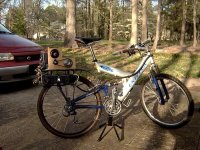Interesting. It's only at 110F but yet it might have been temp? It sounds like a possibility the heat from the lower board didn't dissipate well enough when the motor current started increasing, as the thermal conductivity of thermal grease is quite poor compared to aluminum and copper so it's only effective below a certain amount of thickness(and why it's usually used for direct surface-to-surface applications). According to wikipedia,
http://en.wikipedia.org/wiki/Thermal_conductivity, thermal grease has a thermal conductivity of 0.7 - 3 whereas aluminum has one of 220 (pure), 120--180 (alloys) so the thermal grease is effectively 100x less effective than aluminum foil and if I regularly experience a temperature difference of 10 degrees between the top and bottom(I used aluminum foil), it seems like yours could theoretically go up to a 1000 degree difference or more but it'd kill itself before getting to that point which it sadly enough seems like it did. (Interestingly, though, I thought castle creations said it would "cut itself out" if it went too high since the microcontroller would just temporarily malfunction. Are you positive the Castle Creations controller is still dead? Well, I guess the microcontroller could be been mounted on the top board so it would've gone unscathed anyways.)
I ended up putting aluminum foil between the bottom and top sink and I found the temperature difference between the CPU sink I added on top and the bottom board to be 20-25 degrees fahrenheit, with the difference between the top sink and bottom sink being around 10-15 degrees when the temperature was hovering around 160 degrees fahrenheit.
I also wonder if the added capacitance was enough, as well. I think recumpence ended up adding around 3000-4000 uF and I added 2000 uF and we both haven't experienced problems, yet(But, I also haven't been feeding the controller battery current above 20 amps, either.).
Anyways, nice grapher for temperature! Is eagle-tree some ultra-integrated ADC data logger of some sort?
If I'm reading it correctly, it looks like it was only drawing 15 amps before "cutting the battery current"(It appears to go to zero) but it seems like the temperature increases during the time of no battery current. Uh, so... that seems weird. Defined, it looks like the current cut out at 35 minutes but it looks like the temperature was increasing from 35-36 minutes. Assuming your temperature graph is correct, it also look like the amount of heat generation(properly called "heat" in physics) was greatest shortly before what I assumed was the malfunction at the 36ish minute mark, so that does seem to support your bottom-board-over-heating theory. It looks to be greatest there since the temperature-increase/time looks the greatest there, i.e., the slope of the temperature curve.







